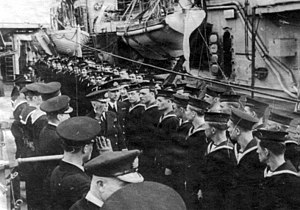ORP Piorun (G65)

ORP Piorun returns to Plymouth after the struggle against the German battleship Bismarck
|
|
| History | |
|---|---|
|
|
|
| Name: | HMS Nerissa |
| Operator: | Royal Navy |
| Ordered: | 15 April 1939 |
| Builder: | John Brown & Company, Clydebank |
| Cost: | £400,963.16s |
| Laid down: | 26 July 1939 |
| Launched: | 7 May 1940 |
| Notes: | Transferred to Polish Navy, October 1940 |
|
|
|
| Name: | ORP Piorun |
| Namesake: | Lightning |
| Operator: | Polish Navy |
| Completed: | 4 November 1940 |
| Acquired: | Transferred to Polish Navy, October 1940 |
| Commissioned: | 4 November 1940 |
| Identification: | Pennant number: G65 |
| Fate: | Returned to Royal Navy, 1946 |
|
|
|
| Name: | HMS Noble |
| Acquired: | August 1946 |
| Recommissioned: | 26 October 1946 |
| Fate: | Scrapped, 1955 |
| General characteristics (as built) | |
| Class and type: | N-class destroyer |
| Displacement: | |
| Length: | 356 ft 6 in (108.7 m) (o/a) |
| Beam: | 35 ft 9 in (10.9 m) |
| Draught: | 12 ft 6 in (3.8 m) |
| Installed power: |
|
| Propulsion: | 2 Shafts; 2 steam turbines |
| Speed: | 36 knots (67 km/h; 41 mph) |
| Range: | 5,500 nmi (10,200 km; 6,300 mi) at 15 knots (28 km/h; 17 mph) |
| Complement: | 183 |
| Sensors and processing systems: |
|
| Armament: |
|
ORP Piorun was an N-class destroyer used by the Polish Navy during the Second World War. The name is Polish for lightning. Ordered by the Royal Navy in 1939, the ship was laid down as HMS Nerissa before being acquired by Poland in October 1940 before completion. Following the Second World War, the vessel was returned to the Royal Navy and recommissioned as HMS Noble until being discarded in 1955.
The ship was built by John Brown & Company of Clydebank, Glasgow. She was laid down in July 1939, launched on 7 May 1940 and completed on 4 November 1940. Initially commissioned into the Royal Navy as HMS Nerissa, she was later transferred to the Polish Navy as a replacement for the destroyer ORP Grom, which had been lost off the Norwegian coast on 4 May 1940.
Piorun was based in Great Britain and commanded by Commander Eugeniusz Pławski. Between 13 and 15 March 1941, while undergoing repairs in John Brown's shipyard, she took part in the defence of Clydebank against air raids by the Luftwaffe. A memorial to the crew of the ship was later erected in Clydebank.
On 22 May 1941, Piorun, with ships of the British 4th Destroyer Flotilla (HMS Cossack, HMS Maori, HMS Sikh and HMS Zulu), commanded by Captain Philip Vian, provided additional escort to troop convoy WS8B en route from Glasgow to the Indian Ocean. On 25 May, Vian's destroyers (including Piorun) were detached from the convoy to join the search for the German battleship Bismarck.
...
Wikipedia
